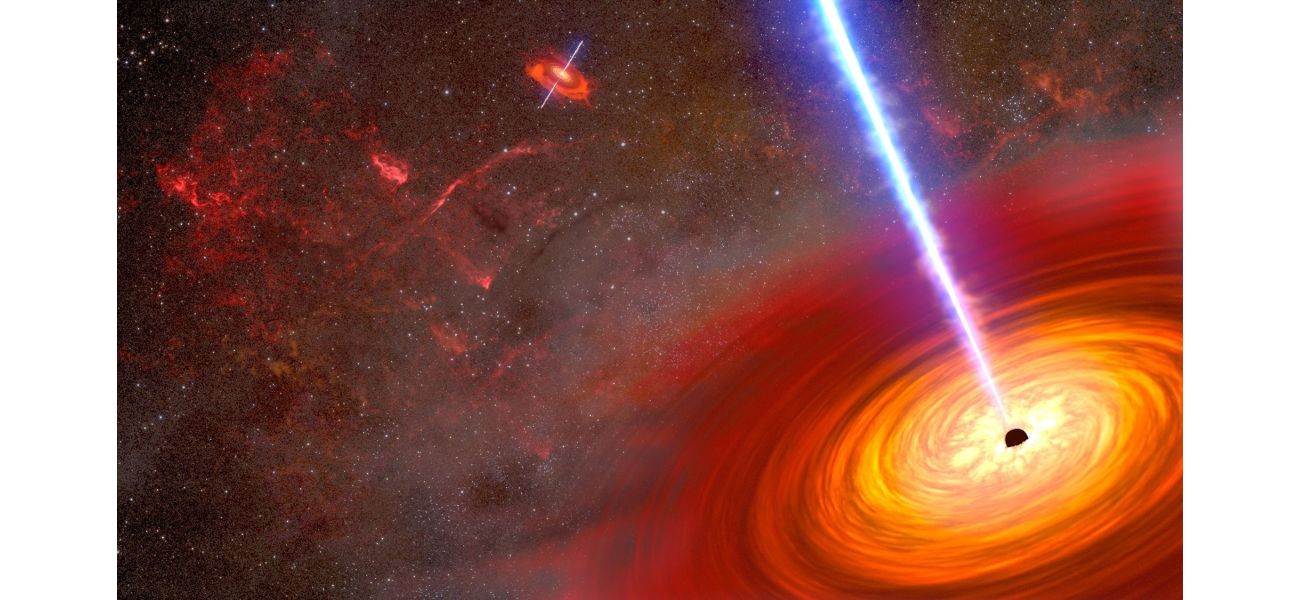Astronomers found a duo of supermassive black holes through bright lights.
Two black holes will eventually combine, creating disturbances in the structure of space and time.
September 15th 2024.

In a groundbreaking discovery, two telescopes have recently detected the closest pair of supermassive black holes ever observed. These two cosmic giants, located a mere 300 light-years from each other, were spotted using NASA's Chandra X-ray Observatory and the Hubble Space Telescope. While black holes are typically invisible against the vast darkness of space, these two were ablaze with bright light due to the gas and dust they were consuming, which became highly accelerated and heated.
Known as active galactic nuclei, these two celestial objects are constantly circling each other, releasing powerful jets of material and high-speed winds that can shape the very galaxies they inhabit. Not only is this black hole duo the closest pair ever found through visible and X-ray light, but it also holds the record for being the closest pair observed in general. While other pairs have been seen before, they were usually much farther apart.
Astronomers made this groundbreaking discovery while studying a pair of colliding galaxies called MCG-03-34-64, located 800 million light-years away. Serendipitously, the team stumbled upon the two black holes when analyzing data from the Hubble telescope, which revealed three spikes of bright light within the galaxy's glowing gas. In a new study published in The Astrophysical Journal, lead author Anna Trindade Falcão, a postdoctoral researcher at the Center for Astrophysics at Harvard & Smithsonian, expressed her surprise at the finding, stating, "We were not expecting to see something like this. This view is not a common occurrence in the nearby universe, and it told us there's something else going on inside the galaxy."
Further examination of the galactic region using Chandra's X-ray capabilities confirmed the presence of two powerful sources of X-ray light, matching the optical light sources seen by Hubble. According to Falcão, "When we put these pieces together, we concluded that we were likely looking at two closely spaced supermassive black holes." The team also consulted archival data from the Karl G Jansky Very Large Array of radio telescopes in New Mexico, which revealed that the black hole duo is also emitting energetic radio waves.
Thanks to Hubble's exceptional resolution, astronomers were able to observe intricate details that would have otherwise gone unnoticed. While other pairs of black holes have been observed at closer distances, those observations were limited to radio wavelengths. These two, however, were detected in a range of wavelengths, providing a more complete picture of their behavior.
The two supermassive black holes once served as the centers of their respective galaxies, but as a result of a galactic merger, they were brought closer together. It is estimated that in about 100 million years, their spiral will lead to a merger, causing a release of gravitational waves - ripples in the fabric of space and time. This significant event could potentially be detected by LISA, the European Space Agency's Laser Interferometer Space Antenna mission, which is set to launch in the mid-2030s. As Falcão puts it, "When you put all the pieces together, it gives you the picture of the duo."
Known as active galactic nuclei, these two celestial objects are constantly circling each other, releasing powerful jets of material and high-speed winds that can shape the very galaxies they inhabit. Not only is this black hole duo the closest pair ever found through visible and X-ray light, but it also holds the record for being the closest pair observed in general. While other pairs have been seen before, they were usually much farther apart.
Astronomers made this groundbreaking discovery while studying a pair of colliding galaxies called MCG-03-34-64, located 800 million light-years away. Serendipitously, the team stumbled upon the two black holes when analyzing data from the Hubble telescope, which revealed three spikes of bright light within the galaxy's glowing gas. In a new study published in The Astrophysical Journal, lead author Anna Trindade Falcão, a postdoctoral researcher at the Center for Astrophysics at Harvard & Smithsonian, expressed her surprise at the finding, stating, "We were not expecting to see something like this. This view is not a common occurrence in the nearby universe, and it told us there's something else going on inside the galaxy."
Further examination of the galactic region using Chandra's X-ray capabilities confirmed the presence of two powerful sources of X-ray light, matching the optical light sources seen by Hubble. According to Falcão, "When we put these pieces together, we concluded that we were likely looking at two closely spaced supermassive black holes." The team also consulted archival data from the Karl G Jansky Very Large Array of radio telescopes in New Mexico, which revealed that the black hole duo is also emitting energetic radio waves.
Thanks to Hubble's exceptional resolution, astronomers were able to observe intricate details that would have otherwise gone unnoticed. While other pairs of black holes have been observed at closer distances, those observations were limited to radio wavelengths. These two, however, were detected in a range of wavelengths, providing a more complete picture of their behavior.
The two supermassive black holes once served as the centers of their respective galaxies, but as a result of a galactic merger, they were brought closer together. It is estimated that in about 100 million years, their spiral will lead to a merger, causing a release of gravitational waves - ripples in the fabric of space and time. This significant event could potentially be detected by LISA, the European Space Agency's Laser Interferometer Space Antenna mission, which is set to launch in the mid-2030s. As Falcão puts it, "When you put all the pieces together, it gives you the picture of the duo."
[This article has been trending online recently and has been generated with AI. Your feed is customized.]
[Generative AI is experimental.]
0
0
Submit Comment





